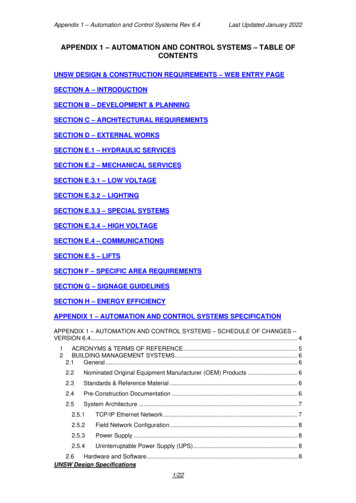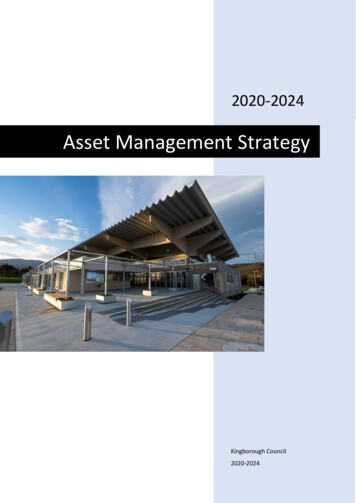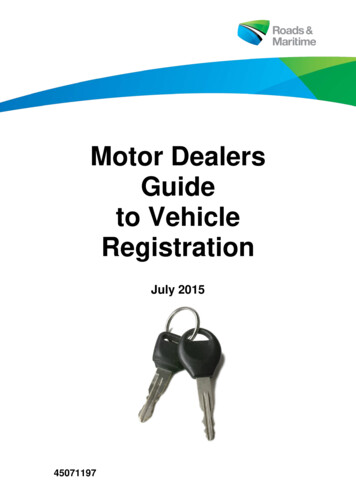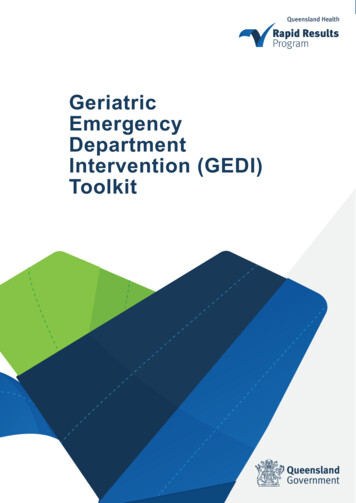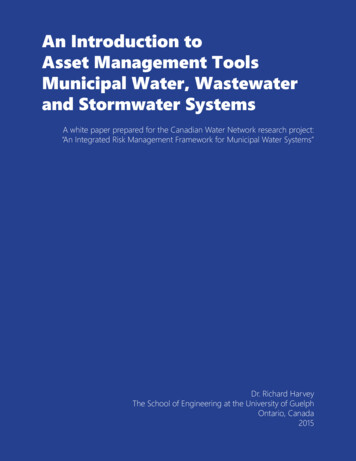
Transcription
An Introduction toAsset Management ToolsMunicipal Water, Wastewaterand Stormwater SystemsA white paper prepared for the Canadian Water Network research project:“An Integrated Risk Management Framework for Municipal Water Systems”Dr. Richard HarveyThe School of Engineering at the University of GuelphOntario, Canada2015
An Introduction toAsset Management Tools forMunicipal Water, Wastewaterand Stormwater SystemsA white paper prepared for the Canadian Water Network research project:“An Integrated Risk Management Framework for Municipal Water Systems”Dr. Richard HarveyThe School of Engineering at the University of GuelphOntario, Canada2015
Prepared by:Richard Harvey, PhDThe School of Engineering at the University of GuelphGuelph, Ontario, CanadaPrepared for:The Canadian Water Network as part of deliverables for the research project “Developmentof Integrated Risk Management Framework for Municipal Water Systems (2015).”Research Team: Edward McBean, Professor and Canada Research Chair in Water Supply Security, TheSchool of Engineering at the University of Guelph.Gail Krantzberg, Professor and Director of the Centre for Engineering and Public Policy,McMaster University.Rob Jamieson, Associate Professor and Canada Research Chair in Cold Regions EcologicalEngineering, Dalhousie University.Andrew Green, Associate Professor, University of Toronto.Partners: City of WaterlooCity of KitchenerTown of OakvilleCity of MississaugaRegion of PeelDurham RegionTown of OrangevilleCity of SurreyCity of CalgaryTown of OkotoksCity of FrederictonCredit Valley Conservation AuthorityAlberta Low Impact Development PartnershipAllstate InsuranceCanadian Standards AssociationInstitute for Catastrophic Loss ReductionEnvironment CanadaOntario Clean Water AgencySouthern Ontario Water ConsortiumClean Nova ScotiaBritish Columbia Ministry of Transportationand Infrastructure WaterTAPEngineers CanadaWest Coast Environmental LawWatson and AssociatesAECOMEcojusticeZizzo Allan Professional CorporationRoyal Roads UniversityCity of North VancouverUniversity of British ColumbiaCarleton University2015 An Integrated Risk Management FrameworkAsset Management White Paper 3
contentsOVERVIEW 3Part 1 ASSET MANAGEMENT 41.11.21.3Standards for Municipal Asset ManagementAsset Management Guidance/EducationCanadian Recommendations for AMPsPart 2 CONDITION ASSESSMENT 142.12.22.32.42.5A Lack of Canadian Infrastructure DataStages of Condition AssessmentInspecting Linear Water Distribution AssetsInspecting Linear Wastewater and Stormwater AssetsThe Need to Inspect Wastewater Force MainsPart 3DEFINING LEVEL OF SERVICE (LoS)293.1Guidance3.2Performance Measures for LoSPart 4 SOFTWARE TRENDS 354.14.2The GIS-Centric ApproachThe WFRF’s Review of Management SystemsPart 5 CONCLUSION 41REFERENCES2015 An Integrated Risk Management FrameworkAsset Management White Paper 4
overviewThe following white paper provides an introduction to select tools and practices thatare helping municipalities in Canada make the shift towards an integrated approach tomanaging water, wastewater and stormwater infrastructure assets.Part 1 - Asset ManagementStrategic, risk-based municipal asset management practices are important during an era ofinfrastructure replacement. Asset Management Plans (AMPs) can be developed to documenthow groups of assets will be managed to provide a satisfactory service level in a sustainableand environmentally responsible manner.Part 2 - Condition AssessmentA critical component of the AMP structure involves risk management, where information onthe physical condition of existing infrastructure is collected and recorded. Although manymunicipalities have traditionally relied solely on expert opinion when determining assetcondition, a wide range of advanced inspection technology and condition assessment toolsare now available for those municipalities seeking accurate and reliable condition data.Part 3 - Defining Levels of Service (LoS)Defining an appropriate LoS for water system infrastructure requires input from stakeholders,the municipality, technical analysis, and risk analysis. Existing LoS systems can help ensureestablished LoS performance indicators are not only focused on the customer but are alsorelevant and attainable.Part 4 - Software TrendsThe ability for a municipality or utility to effectively manage its water and wastewater infrastructureassets will largely be controlled by its ability to organize large amounts of data. A wide variety oftechnologies that support asset management are now available to municipalities and utilities.Part 5 – ConclusionA series of barriers to asset management still exist in Canada. Embracing standardization ofasset management practice and state-of-the-art software tools is a necessity for sustainablegrowth and development.2015 An Integrated Risk Management FrameworkAsset Management White Paper 5
pt 1. asset management 75% of the respondentsin a 2012 survey of 451utilities in North America’swater and wastewaterinfrastructure sectorchose aging infrastructureas one of the mostimportant factors leadingto the implementationof asset managementpractices [1].Click here to see thereport.Widespread concern for the state of water and sewerinfrastructure in North America has motivated a push overthe past few years for wide-spread adoption of advancedmanagement practices developed with an intention to maintaininfrastructure assets at an acceptable level of risk while continuouslydelivering established levels of service. A wide-range of benefits arereceived when municipalities adopt advanced techniques for assetmanagement. When considering infrastructure assets (those stationarywater, wastewater and stormwater components with an independentphysical and functional identity and age), asset management practiceseffectively lower the cost of infrastructure renewal, extend the lifeof existing assets and will ultimately help ensure adequate fundingfor the activities essential for a municipality’s sustained growth anddevelopment over time.1.1 STANDARDS FOR MUNICIPAL ASSET MANAGEMENTClick here to learn moreabout the ISO 55000series of standards forasset management [2].For many years, one of the major obstacles preventing widespreadadoption of advanced asset management practices at the municipallevel has been a lack of consistent standards and terminology amongpractitioners. Fortunately, the ISO 55000 series of standards introducedin 2014 now provides practitioners with a standardized overview ofthe subject of asset management, and the key requirements for theestablishment, implementation, maintenance and improvement of aneffective asset management system.Defining Key Terms Asset: something that has potential or actual value to an organization.Asset Management (AM): coordinated activity to realize asset value.Asset Management Objective (AMO): result required from an asset.Asset management Plan (AMP): documents the strategic activities, resources, and timescalesrequired for an individual asset or a grouping of assets to achieve defined AMOs [3].2015 An Integrated Risk Management FrameworkAsset Management White Paper 6
1.2 ASSET MANAGEMENT GUIDANCE/EDUCATIONClick here for a “QuickGuide” to using the IIMMto meet the requirementsof ISO 55000 [5].Click here to accessthe IPWEA’s PracticeNotes for AssetManagement andFinancial Planning [6].While the ISO 55000 standards provide useful information on “what”is required of an asset management system, they do not provideasset-specific guidance on “how” an organization should achieveISO requirements. Municipalities seeking a practical approachto implementing effective management practices for a range ofinfrastructure assets can refer to the International InfrastructureManagement Manual (IIMM) developed by the Institute of PublicWorks Engineering Australasia (IPWEA) [4]. The IIMM contains over100 case studies collected from a range of countries demonstratinggood asset management practice and is used by a number ofCanadian municipalities (e.g. Cambridge, Ontario).The IPWEA also develops and maintains a series of Practice Notes thatcan assist practitioners with asset management and financial planning[6]. Although primarily developed using input from practitioners inAustralia and New Zealand, these Practice Notes are internationallyapplicable (with some containing Canadian case study applications: Click to access the free,on-line copy of PracticeNote 6: Long-termFinancial Planning [7]. PN 4 Asset Management for Small, Rural or Remote Communities(Version 1 published in 2011, 140 pages, available free to smallAustralian councils): provides access to on-line templates formanaging assets with knowledge, understanding and commitment.PN 5 Stormwater Drainage (Version 1 published in 2011, 150excluding taxes): assists practitioners in applying best practicefor asset management, condition assessment and performanceinspection for various stormwater systems (e.g. traditionalunderground conduit systems and lined open channel systems).PN 6 Long-term Financial Planning (Version 1 published in 2012,free on-line access): provides guidance and a tool-kit that can helpan organization prepare a long-term financial plan without use ofproprietary software (simple excel model with 15 worksheets witha how to guide to assist with the setup).PN 7 Water Supply and Sewerage (Version 2 published in 2014,124 pages, 220 excluding taxes): provides guidance for conditionand performance assessment. Sections included that specificallyrelate to ISO 55000 compliance. Provides access to a spreadsheetthat can help select the priority and timing of renewals.PN 8 Levels of Service (Version 1 published in 2014, 220 excludingtaxes): practice note examines in detail the purpose of communityengagement, developing levels of service (and service options),developing a community engagement plan, determiningaffordable and acceptable service levels, and delivering agreedservice). Provides access to a case study of the Township ofLangley, British Columbia.2015 An Integrated Risk Management FrameworkAsset Management White Paper 7
Tom’s Bad Day:Click to discover theEPA’s storyline approachfor interactive assetmanagement training [8].Click to access the EPA’sBest Practices Guide forAsset Management [9].The United States Environmental Protection Agency (EPA) hasdeveloped interactive training material covering the fundamentalsof discovering and applying advanced asset management practicesto a utility environment. Recognizing the reality that utilities andmunicipalities increasingly need to do more with existing resources,the training material highlights the real savings asset managementprovides via efficiency gains, cost avoidance and cost effectivenessand redirection. The EPA’s training material (PDF and flash videos)is structured as a hands-on approach to learning holistic assetmanagement practices that aim to maintain a level of service atthe lowest life-cycle cost at an acceptable level of risk. A real-worldstoryline referred to as “Tom’s Bad Day” (a utility director dealing withmanagement problems – e.g. pump station issues, sanitary seweroverflows, maintenance budget short-falls, and broadly with utilitymanagement) is used to help users think about the principles andobjectives of asset management within the context of a realisticsetting [8].The EPA has also made available a Best Practices Guide for assetmanagement for water systems [9]. Released in 2008, the guide wasdeveloped for owners, managers, and operators of water systems,local officials, and technical assistance providers. Although releasedbefore ISO 55000 standardization, the material is still relevant and ofutility when gaining familiarity with aspects of asset management. Itcovers: SIMPLE:Click to discover theWERF’s web-based assetmanagement learningenvironment [10].Challenges faced by water systems (e.g. increasing demands forservices, overcoming resistance to rate increases, etc.).Benefits of asset management (e.g. prolonging asset life, meetingconsumer demands with a focus on system sustainability, meetingservice expectations and regulatory requirements, etc.).A framework for implementing asset management based aroundfive core questions: (1) Current state of Assets, (2) Level of Service,(3) Critical Assets, (4) Minimum life cycle cost, and (5) Long-termfunding plan.The Water Environment Research Foundation (WERF) and theWater Research Foundation (WRF) have been active in the field ofadvanced asset management. They have made available a rangeof tools to facilitate asset management at the utility/municipal level.Their Sustainable Infrastructure Management Program LearningEnvironment (SIMPLE) serves as a web-based resource existingat two levels – an “Introductory Level” provides free, basic assetmanagement information. The “Practitioner Level” is available toWERF and WRF subscribers and provides more advanced guidance,case studies and information on processes and that can be used fortasks such as risk assessment and establishing levels of service [10].2015 An Integrated Risk Management FrameworkAsset Management White Paper 8
1.3 CANADIAN RECOMMENDATIONS FOR AMPsAlthough nation-wide standards for asset management planningare not currently enforced, there has been a move towardsstandardization and consistency in municipal asset management insome provinces. Considering Ontario as an example, the provincehas made it a requirement that any municipality seeking provincialcapital funding needs a detailed asset management plan (AMP) andmust be able to show how the intended project falls within that plan.In general, AMPs contain information related to the characteristicsand conditions of infrastructure assets owned by a municipality, levelsof service expected for those assets, clear actions that ensure assetsare providing the expected level of service, and financing strategiesfor sustainability.Click to discoverthe CNAM’s AssetManagement Primer [11].Click to discover theMOI’s guidance ondeveloping effectiveAMPs [12].The Canadian Network of Asset Managers released an “AssetManagement Primer” in support of the Canadian InfrastructureReport Card [11]. The primer provides recommendations for AMPstructure based partly on guidance provided in the Ontario Ministryof Infrastructure’s “Building Together – Guide for Municipal AssetManagement Plans” [12]. Following that guidance, an effective AMPwould contain the following six sections:1. Introduction: documents assets that are within the scope of theAMP, the goals of the municipality and clarifies the relationshipbetween the AMP and other corporate planning documents.2. State of the Infrastructure: documents the inventory, age, condition,and replacement value of assets owned by the municipality.3. Levels of Service: Documents the current level of service beingprovided and describes what the municipality is measuring toensure level of service targets are being effectively met.4. Plan Monitoring and Improvements: key asset renewal projectsand changes that might impact the next round of AMP goals.5. Asset Strategies: establishes 10 year and longer term renewalplans, strategies used to reduce cost of rehabilitation, etc.6. Financing Strategy: how the municipality will reach a point whereavailable revenues equal asset renewal needs [11].“Asset management planning will allow needs to be prioritizedover wants. It will help ensure that investments are made at theright time to minimize future repair and rehabilitation costs andmaintain municipal assets.“--- “Building Together: Guide for Municipal Asset Management Plans” [12]2015 An Integrated Risk Management FrameworkAsset Management White Paper 9
CANADIAN SPOTLIGHTOntario MOI’s Asset Management ToolkitThe province of Ontario released a long-term infrastructure plan/strategy in the summerof 2011 to ensure province-wide implementation of effective asset management practices[13]. The goals of this strategy include making good asset management planning universal,moving toward optimal use of a full range of infrastructure financing tools, and addressingstructural challenges facing small communities. The strategy indicates how, over a ten yearperiod, the province will work with municipalities to ensure financial and environmentalsustainability of water, wastewater, and stormwater systems through activities on severalfronts, including: Enforcing the requirements of the Water Opportunities Act,first passed in the summer of 2010 to improve the efficiencyof municipal infrastructure. This legislation requires thepreparation of municipal water sustainability plans thatinclude performance measures and targets for municipalwater, wastewater and stormwater systems.Making improved asset and financial management practices,preconditions for provincial infrastructure grants. Thestrategy makes the development of comprehensive AMPsa requirement for municipalities requesting provincialinfrastructure funding.More than 80% of drinking water systems in the province servefewer than 10,000 people and these smaller municipalities oftenlack the technical capacity or financial resources necessary for thepreparation of detailed AMPs. In addition to funding strategies(e.g. the 100-million per year Ontario Community InfrastructureFund (OCIF) launched in the summer of 2014 to support therevitalization and repair of critical infrastructure in small, ruraland northern communities), the province has also developed aguide to preparing municipal AMPs [9].Click to access “BuildingTogether” - Ontario’slong-term infrastructurestrategy [13].Click to access the MOI’sGuide to DevelopingMunicipal AssetManagement Plans [12].The MOI’s guide is part of a web-based toolkit [14] that contains a variety of tools designedto help municipalities with the execution of their AMP: A communications tip-sheet designed to help municipalitieseffectively communicate the benefits of asset managementplanning to a broad range of audiences.A self-assessment checklist/questionnaire intended to start areview of current asset management practices.Sample state of the infrastructure reports that cover assettypes, financial accounting valuation, replacement costvaluation, asset age distribution and asset condition.A risk management primer covering aspects related toconsequence and likelihood of failure, identification ofcritical assets and strategies for managing risk.A life-cycle costing primer covering the fundamentals ofestimating the life-cycle cost of various asset managementstrategies.Click to access the MOI’smanagement tookit ilding together mis/tools.asp2015 An Integrated Risk Management FrameworkAsset Management White Paper 10
CANADIAN SPOTLIGHTSaskatchewan’s Website Dedicated to Improving MunicipalStakeholder Capability for Asset ManagementThe province of Saskatchewan maintains a website designed to increase municipalstakeholder knowledge of municipal asset management practices. Managed througha collaborate effort of several associations (e.g. the Saskatchewan Urban MunicipalitiesAssociation, Ministry of Municipal Affairs, and individual municipalities throughout theprovince),The website provides access to a variety of useful asset management resources, includinga series of videos that were developed to raise awareness about why asset management isimportant for municipalities. The videos are structured around a set of chapters consistingof interviews with industry professionals: Chapter 1 – State of Affairs (2 minutes): identifies the threatposed by aging infrastructure and the need to rehabilitateassets for use by future generations [12].Chapter 2 – Asset Management Principles (6 minutes):covers integrated asset management planning for achievinglong-term sustainability, full-cost accounting of an asset,the benefit of developing asset registers that form thestarting point for asset management plans, choosing levelsof service and communicating the challenges around assetmanagement.Chapter 3 – Asset Management Process (5 minutes):the relationship between municipal stewardship, assetmanagement planning and financial planning.Chapter 4 – Call to Action (2 minutes): the benefits receivedwhen asset management planning practices are adopted atthe municipal-level.The asset management videos can be viewed used in tandemwith Saskatchewan’s Guide to Getting Started with AssetManagement that provides a general introduction to assetmanagement practices at the municipal level [16].Click to watchSaskatchewan’s assetmanagement videos [15].Click to access the Guideto Getting Started withAsset Management [16].The asset management website also contains a number of links to presentations and casestudies covering topics related to the Public Sector Accounting Board’s PS 3150 TangibleCapital Asset (TCA) implementation. First introduced in 2009, PS 3150 was considered tobe one of the biggest changes in the history of Canadian municipal accounting as tangiblecapital assets had to be identified, counted, valued, and amortized.http://assetmanagementsk.ca/index2015 An Integrated Risk Management FrameworkAsset Management White Paper 11
CANADIAN SPOTLIGHTAsset Management British ColumbiaAsset Management British Columbia represents a group of local government representativesin administrative, technical, operational, financial, planning, and political disciplinesas well as key industry associations [17]. In September 2010 the organization released the“State of Asset Management in British Columbia” - containing the results of interviewswith key representatives from 39 local British Columbia governments on the state of assetmanagement in the province [18].Like many other Canadian provinces at the time, the interviewssuggested the state of asset management in British Columbiavaried widely across communities and that asset managementpractices often vary across services within the same localgovernment. No two governments were found to have identicalcircumstances nor did they take identical approaches to assetmanagement. One of the key challenges facing local governmentswith respect to asset management was found to be a limitedamount of financial resources [18].Click to access the 2010report: “State of AssetManagement in BritishColumbia” [18].The opportunities identified inthe State of Asset Managementreport were then prioritized andincorporated into Asset ManagementB.C.’s recently released frameworkfor Sustainable Service Delivery [19].The framework represents a highlevel, systematic approach that willsupport the move local governmentsin British Columbia are makingtowards service, asset and financialsustainability. It highlights thereality that asset management is anongoing process that is incrementaland scalable and that effectiveinternal and external communicationof progress is of critical importance.A short-version of the framework iscurrently available (the long-versionis scheduled to be released in 2015(click image on the right to go to theframework).Asset management B.C.’s website also provides links to a widevariety of resources related to understanding sustainable servicedelivery, asset management planning, and long-term financialplanning. As an example, the “AssetSMART” tool (preparedby the professional consulting firm Urban Systems for B.C.’sMinistry of Community and Rural Development” helps localgovernments evaluate their capacity to manage their assets [20].Click to accessAssetSMART [20].http://www.assetmanagementbc.ca/2015 An Integrated Risk Management FrameworkAsset Management White Paper 12
CANADIAN SPOTLIGHTBritish Columbia’s Master MunicipalConstruction Documents Association (MMCDA)The Master Municipal Construction Documents Association (MMCDA) represents acollaborative collection of government, consultants, contractors and owners that haveworked together since 1989 to solve challenges facing municipal infrastructure projects inBritish Columbia [21].The MMCDA has developed the free-to-use Asset Management Data Repository (AMDR)to bring standardization to the way local governments work with infrastructure data. TheAMDR contains two core components: Infrastructure Data Schema (IDS): containing standards for infrastructure namingconventions, physical description of attributes and life-cycle management. The IDS isopen-source and compliant with the Public Sector Accounting Board’s Statement 3150.Infrastructure Data Management Utility: a tool that can be used to create, manage andreport infrastructure data in a manner that is consistent with accounting guidelines fortangible capital assets.The AMDR schema incorporates a variety of infrastructuretypes including storm drainage, sanitary sewers, waterdistribution systems, transportation and electricalinfrastructure [22]. The MMCDA website also contains a set ofvideo resources related to infrastructure asset management,including webinars dealing directly with: The asset management data repository project (49 minutes- an introduction to the AMDR)Perspectives on asset management in British Columbia (8minutes - a brief introduction to difficult challenges).Engineering Challenges in Asset Management (38 minutes exploring questions such as “What do you own and what isit worth?”)Planning Strategies for Asset Management (47 minutes- topics such as how asset management fits with officialcommunity plans and the overall planning process).Financial Management Challenges for Asset Management(31 minutes - covering topics related to challenges oftenfaced when integrating existing financial systems with assetmanagement systems).Leadership and Management for Asset Management(45 minutes - addresses questions related “How do weintegrate all our processes? What is the role of council andstaff? What has to change to make it work?”) [23].Click to access thefree-to-use AssetManagement DataRepository (AMDR) [22].Click to access theMMCDA’s video serieson infrastructure assetmanagement [23].https://www.mmcd.net/2015 An Integrated Risk Management FrameworkAsset Management White Paper 13
pt 2. condition assessmentCondition assessment is a critical component of the assetmanagement process as it provides the data necessary toevaluate the risk of failure of individual assets. In this way,it helps utilities make informed decisions and is one of the mosteffective strategies for allocating funds for the repair, maintenanceand replacement of existing water and wastewater assets [1].2.1 A LACK OF CANADIAN INFRASTRUCTURE DATAThe 2012 Canadian Infrastructure Report Card (CIRC) indicates that ofthe 346 surveyed municipalities:Less than 15% ofmunicipalities in the2012 CIRC survey wereable to provide assetcondition data derivedfrom an established assetmanagement process[24]. 41% had no data on the condition of their water distribution pipes17% had reliable data on water distribution pipe condition.48% had no data on water transmission pipe condition.14% used reliable data to assess water transmission pipe condition.33% had no data on their wastewater linear assets.53% had no data on their stormwater linear assets.4.5% use complete and reliable assessment data when assessingstormwater system capacity [24].Many municipalities use purely age-based assumptions of conditionwhen assessing the current state of their infrastructure assets.There is a significant amount of risk associated with this practice asrehabilitation/replacement decisions based only on age will providea number that if funded, might result in misleading projections ofcondition and unnecessary allocation of funds to replace olderassets that actually have a significant amount of useful life remainingdespite their age. In general, the concept of conducting conditionassessment through established asset management practices is stillan emerging issue in Canada – with municipalities increasingly awareof the necessity to take action, but the level of action taken is still inthe early stages.2015 An Integrated Risk Management FrameworkAsset Management White Paper 14
Evaluateappropriatenessof differentmethods ofinspection.Select suitabletechnology andperform assetinspection.STAGE 4Evaluateconsequence offailure. Conditionassessmentwill identifylikelihood offailure.Risk assessmentprovides clearidea of whichassets to inspect.STAGE 3STAGE 2STAGE 1Reviewavailable data(historical,environmental& operational)relating tothe asset inquestion.Identifydata gaps &prioritize assets.Final conditionassessmentbasedpreviousstages Definecondition ofthe asset andcapabilityto achievedrequired levelof service.2.2 STAGES OF CONDITION ASSESSMENTThe infrastructure condition assessment process for linear water andwastewater infrastructure essentially consists of four stages [25]. Thefirst stage entails a review of all the information a municipality hasmaintained for the asset in question (e.g. as-built drawings, operatingdata, maintenance history, previous failures, rehabilitation actions,and interviews with experienced personnel). A key outcome of thisstage in the process is the identification of any particular gaps inknowledge (i.e. the provision of a general indication of the extent ofasset inspection that might be required).Likelihood ofFailure(LOF)LowThe second stage of the process consists of evaluating the risksassociated with the failure of an infrastructure asset. Every failure isunique, and quite often, risks are not always well defined (with mostinformation on consequences being anecdotal). One of the moreversatile approaches for defining risk is centered on risk matrices thatestablish both the consequence of failure (COF) and probability offailure (POF).COF is typically established by considering arange of dimensions, including the cost of repair,health and safety, costs associated with damage tosurrounding infrastructure, environmental impactsand reduction in level of service [13]. Based on thisHighevaluation, COF for an asset may take the form ofRiska
Strategic, risk-based municipal asset management practices are important during an era of infrastructure replacement Asset Management Plans (AMPs) can be developed to document how groups of assets will be managed to provide a satisfactory service level in a sustainable and environmentally responsible manner Part 2 - Condition Assessment

